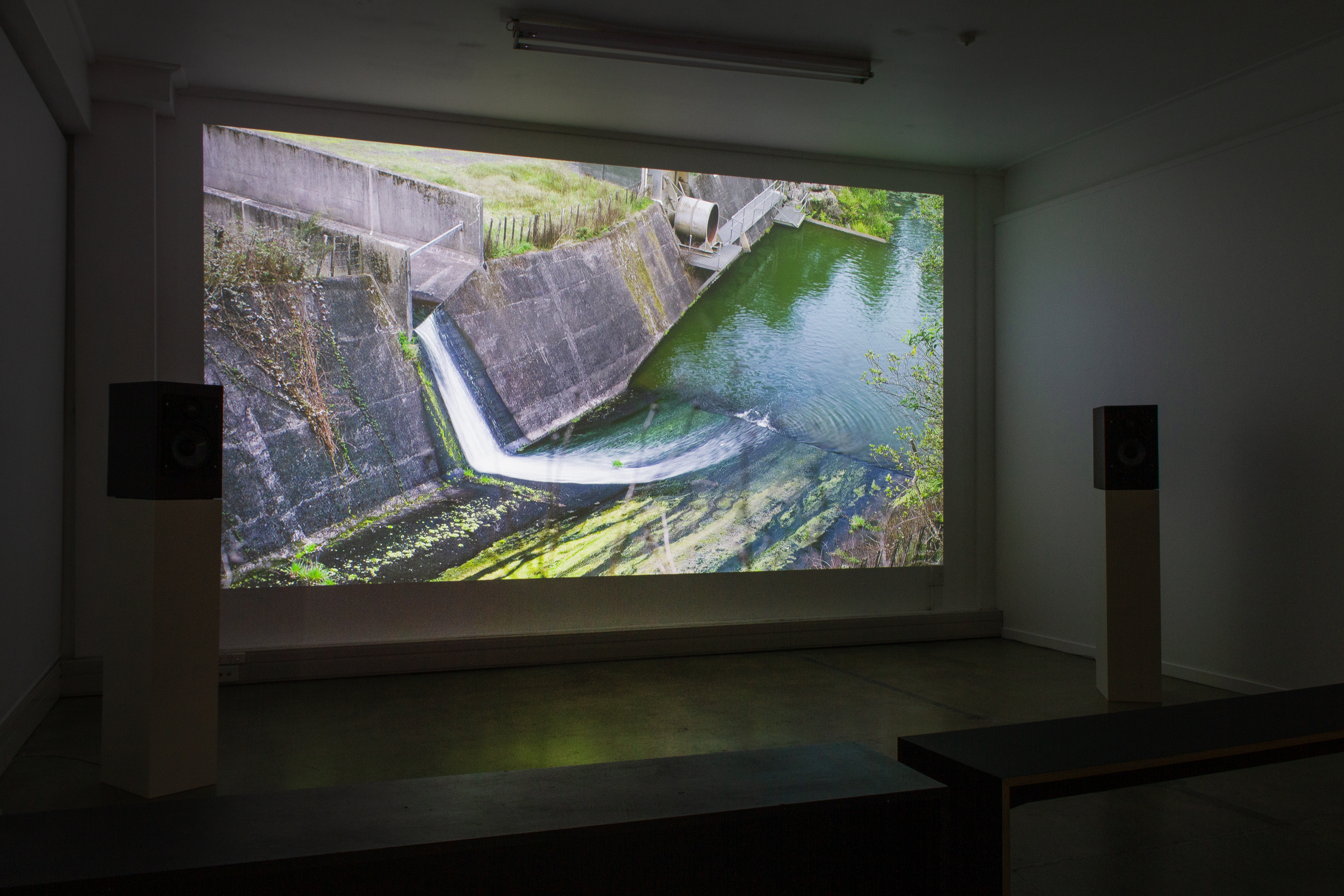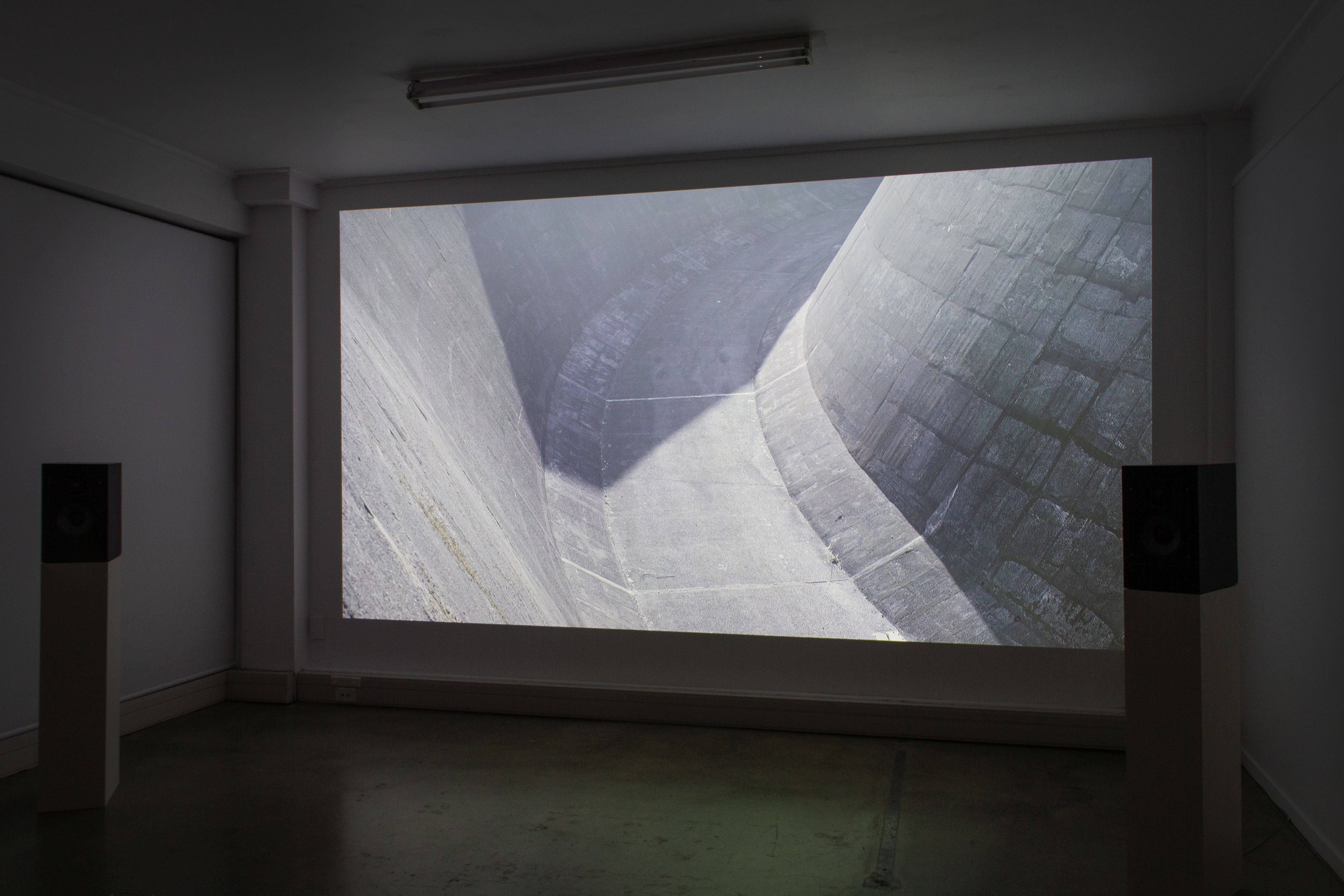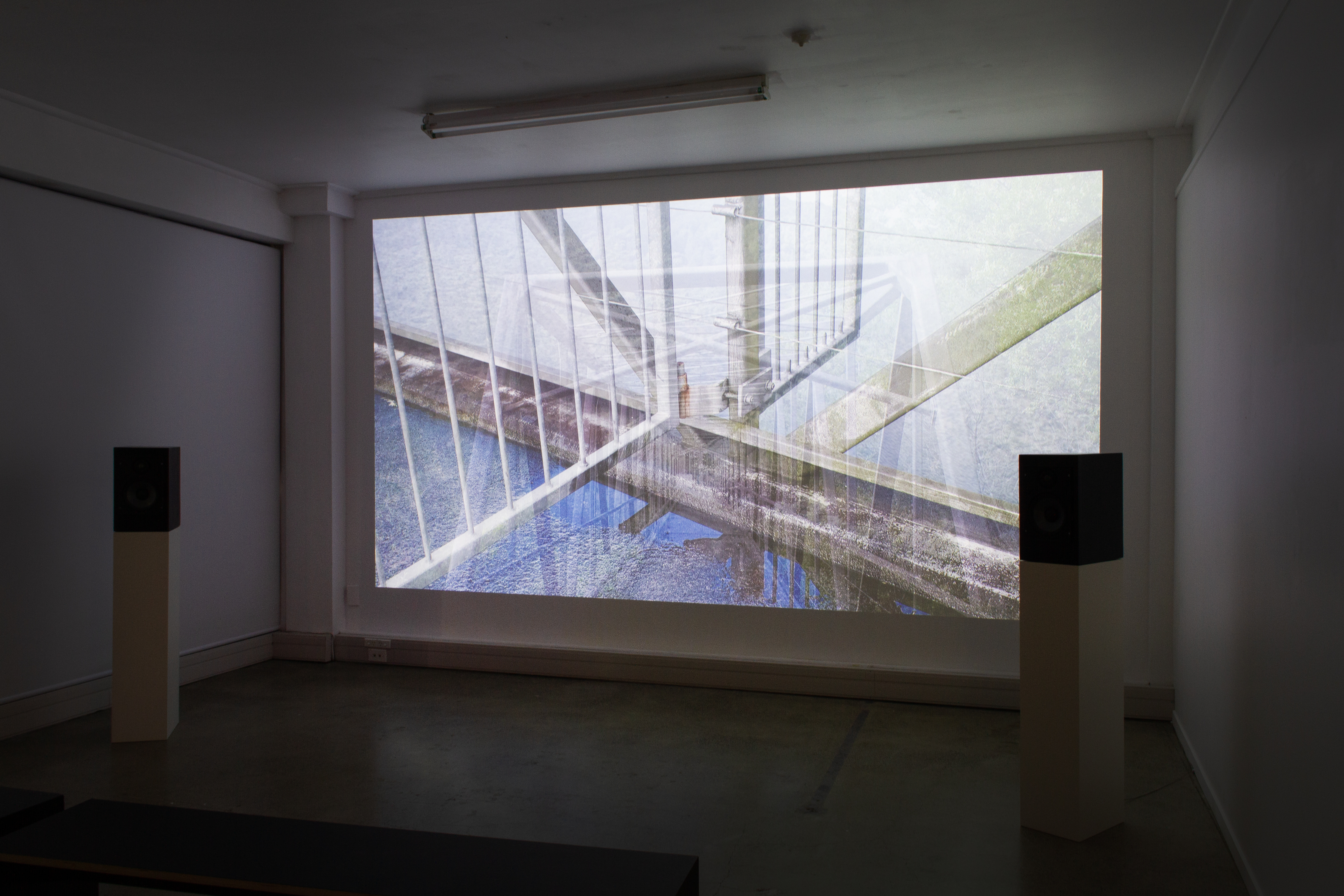
Entanglement
Exhibition by Josh Carlier
Entanglement | Josh Carlier | RM, Tāmaki Makaurau
06.04.23 | written by Nathan Regal
New Topographics Photographs of a Man-altered Landscape opened at the International Museum of Photography at George Eastman House, Rochester, New York in 1975. Drawing on the aesthetic legacies of Walker Evans and their contemporary Ed Ruscha, the photographers depicted prosaic, largely unpeopled views of North America with a “minimum of inflection”.1 Though making no claims to objectivity, the artists sought to suppress their authorial voices, creating ambiguous images which called on the subjectivity of the viewer.
Josh Carlier’s Entanglement “aims to extend the photographic tradition of New Topographics, into a temporal and contemporary context here in Aotearoa”.2 The moving-image work consists of a series of patiently observed views of water reservoirs in the Hunua and Waitakere Ranges and a soundtrack composed from recordings from these sites. Carlier cuts or dissolves between wide shots—capturing expanses of water or concrete—and smaller details like dried algae caught in twigs or the wavering of a reflected tree branch, underscored by ambient birdsong and the metallic resonances of pipes and bridges. Throughout, he remains careful both to capture the human interventions that have reshaped these landscapes, and the ways that nature has sought to take them back. What might underlie Carlier’s impulse to draw on an American exhibition from 50 years ago to picture the boundaries and infrastructure of contemporary Tāmaki Makaurau?
Josh Carlier’s Entanglement “aims to extend the photographic tradition of New Topographics, into a temporal and contemporary context here in Aotearoa”.2 The moving-image work consists of a series of patiently observed views of water reservoirs in the Hunua and Waitakere Ranges and a soundtrack composed from recordings from these sites. Carlier cuts or dissolves between wide shots—capturing expanses of water or concrete—and smaller details like dried algae caught in twigs or the wavering of a reflected tree branch, underscored by ambient birdsong and the metallic resonances of pipes and bridges. Throughout, he remains careful both to capture the human interventions that have reshaped these landscapes, and the ways that nature has sought to take them back. What might underlie Carlier’s impulse to draw on an American exhibition from 50 years ago to picture the boundaries and infrastructure of contemporary Tāmaki Makaurau?

It is tempting to analogise between the present and the mid-‘70s. Both are periods of: inflation and economic instability; prominent intellectual discourses of the environment and information; political stagnation; energy crises (of very different kinds); violence as spectacle; pervasive paranoia … But the analogy is easily overdrawn. The ‘70s followed and consolidated the failures of a period of immense political potential. Those potentials remained proximate, if decreasingly charged. Genuinely radical potentials for change are now firmly in the past. In further contrast to the ‘70s, we are not only faced with immediate crises, but a future horizon of chronic environmental crisis punctuated with acute episodes of destruction.
One reading of New Topographics would accuse the artists of passive acceptance of their degraded present. The exhibition’s images of industrial decline and urban sprawl refuse didacticism or even clear commentary, seemingly united in the conviction shared by Nicholas Nixon in the catalogue text that “[the] world is infinitely more interesting than any of my opinions concerning it.”3 There is a faith here that the image, alone, is enough.
The photographs were a necessary, collective rejection of Ansel Adams and Minor White’s impossible escapes to an imagined “unspoiled” nature, but they presented no clear imaginative alternative to it. If there is a programme for the future in the images, it is analytic, not active, suggestive of the need to “think” the present, not intervene in it.
Given Tāmaki’s recent flooding and future of further environmental chaos, a visual language of ambiguity and ambivalence is perhaps an unlikely candidate for a contemporary envisioning of the city’s water systems. However, by translating this photographic style into film and altering the relationship between the viewer and the artwork, Carlier suggests that the dispassionate techniques of New Topographics can be a tool for envisioning interconnection and flux.
While New Topographics’ demands on the individual viewer’s subjectivity remain, Carlier seems less concerned with concealing his own presence in the production of the work. The hand of the artist becomes more visible in decisions like the extensive use of slow dissolves. As the mid-points of these dissolves approach, the previously legible objects pictured are transformed into abstractions. Different views of a bridge are layered into a dense lattice of steel; a spillway collides in on itself. At other times, the apparent stability of concrete is unsettled by dissolves into water. The monumental and solid is repeatedly revealed to be temporary and fragile.
One reading of New Topographics would accuse the artists of passive acceptance of their degraded present. The exhibition’s images of industrial decline and urban sprawl refuse didacticism or even clear commentary, seemingly united in the conviction shared by Nicholas Nixon in the catalogue text that “[the] world is infinitely more interesting than any of my opinions concerning it.”3 There is a faith here that the image, alone, is enough.
The photographs were a necessary, collective rejection of Ansel Adams and Minor White’s impossible escapes to an imagined “unspoiled” nature, but they presented no clear imaginative alternative to it. If there is a programme for the future in the images, it is analytic, not active, suggestive of the need to “think” the present, not intervene in it.
Given Tāmaki’s recent flooding and future of further environmental chaos, a visual language of ambiguity and ambivalence is perhaps an unlikely candidate for a contemporary envisioning of the city’s water systems. However, by translating this photographic style into film and altering the relationship between the viewer and the artwork, Carlier suggests that the dispassionate techniques of New Topographics can be a tool for envisioning interconnection and flux.
While New Topographics’ demands on the individual viewer’s subjectivity remain, Carlier seems less concerned with concealing his own presence in the production of the work. The hand of the artist becomes more visible in decisions like the extensive use of slow dissolves. As the mid-points of these dissolves approach, the previously legible objects pictured are transformed into abstractions. Different views of a bridge are layered into a dense lattice of steel; a spillway collides in on itself. At other times, the apparent stability of concrete is unsettled by dissolves into water. The monumental and solid is repeatedly revealed to be temporary and fragile.

The work’s soundtrack mirrors the abstractions created by each dissolve. Composed using samples collected from Hunua and Waitakere, the timbres are evocative, but their exact sources are often unclear. Ambient sound from the edge of the reservoirs mixes with contact mic recordings from the metal structures around them. Sounds from one site may mix with images from another. As with the visual dissolves, aural abstractions emerge from the superimposition of specific sources. In an urban water supply, geographically disparate water sources commingle through technological intervention to reach the consumer as a seemingly complete commodity: a glass of water. Entanglement’s sounds and images similarly elide distance and time into a simultaneity capable of consumption.
The act of contemplation is built into moving image in a way that is absent in static visual media. Unlike a photograph, which can be viewed (if not comprehended) at a glance, being able to see the whole of a video piece is a necessarily durational commitment. Carlier conceives of the piece as “time based photography”—primarily reliant on photographic rather than cinematic conventions, but imbued with the temporal dimension of film.4 Through its duration (19 minutes 7 seconds) and absence of narrative elements, Entanglement encourages the viewer to consider their position in the system that is pictured. Here, the geographical specificity of the work (Hunua and Waitakere) and its display location (RM Gallery, off Karangahape Road) creates a different charge between art and viewer than that of New Topographics.
New Topographics pictured locations from across the vastness of North America. For the audience member viewing these works at Eastman House in Rochester, New York, the relationship between the viewer and housing developments in Colorado or derelict coal-breakers in Pennsylvania was likely abstract, not direct. The images could serve as analogies for more proximate forms of change or development or destruction or alienation. For the viewer sitting in RM Gallery watching Entanglement, their implication in the work is direct, not abstract. Their ability to be in central Tāmaki Makaurau as a resident or visitor is dependent on the water delivered by the infrastructure depicted in the work.5
Although the ambiguity of Entanglement means that this implication could be overlooked on a casual viewing, patient consideration of the work precipitates a subtle shift from New Topographics in the relationship between viewer and artwork. Dependence on the depicted water infrastructure circumscribes the engaged viewer’s range of possible responses. In particular, it undermines the satirical or scornful readings of the subject matter that can easily be brought to New Topographics. The objects in Entanglement may be charged with a sense of foreboding, as in the opening shot of thin fog rolling across an empty open channel spillway, or a faint sense of absurdity, as in the bell-mouth spillways—large concrete structures that resemble plugholes—but the viewer is nonetheless embedded in the web of their necessity.
The act of contemplation is built into moving image in a way that is absent in static visual media. Unlike a photograph, which can be viewed (if not comprehended) at a glance, being able to see the whole of a video piece is a necessarily durational commitment. Carlier conceives of the piece as “time based photography”—primarily reliant on photographic rather than cinematic conventions, but imbued with the temporal dimension of film.4 Through its duration (19 minutes 7 seconds) and absence of narrative elements, Entanglement encourages the viewer to consider their position in the system that is pictured. Here, the geographical specificity of the work (Hunua and Waitakere) and its display location (RM Gallery, off Karangahape Road) creates a different charge between art and viewer than that of New Topographics.
New Topographics pictured locations from across the vastness of North America. For the audience member viewing these works at Eastman House in Rochester, New York, the relationship between the viewer and housing developments in Colorado or derelict coal-breakers in Pennsylvania was likely abstract, not direct. The images could serve as analogies for more proximate forms of change or development or destruction or alienation. For the viewer sitting in RM Gallery watching Entanglement, their implication in the work is direct, not abstract. Their ability to be in central Tāmaki Makaurau as a resident or visitor is dependent on the water delivered by the infrastructure depicted in the work.5
Although the ambiguity of Entanglement means that this implication could be overlooked on a casual viewing, patient consideration of the work precipitates a subtle shift from New Topographics in the relationship between viewer and artwork. Dependence on the depicted water infrastructure circumscribes the engaged viewer’s range of possible responses. In particular, it undermines the satirical or scornful readings of the subject matter that can easily be brought to New Topographics. The objects in Entanglement may be charged with a sense of foreboding, as in the opening shot of thin fog rolling across an empty open channel spillway, or a faint sense of absurdity, as in the bell-mouth spillways—large concrete structures that resemble plugholes—but the viewer is nonetheless embedded in the web of their necessity.

New Topographics appears to have been plucked from the archive for its ability to picture complex human interactions with the landscape without resorting to simple moralising. It provides the capacious ambiguity that is necessary when picturing human structures and our relationship to them. Ambiguity can also, however, lend itself to a banal pluralism, where the multiplicity of possible interpretations renders a work effectively meaningless. Carlier attempts to evade this trap by depicting a system in which the viewer is directly entangled. The formal approaches to landscape present in New Topographics, where the viewer stands as an alienated observer surrounded by the traces of human action, but few actual people, are recast by Carlier as a system for imagining interconnection. The space for ambiguity remains, but its limits are defined by the viewer’s reliance on the reservoirs. This is a precarious detournement of a visual system symptomatic of the early fractures of postmodernity—a reaching for connection, if not wholeness, through a style born of alienation. Anchored within a concrete relationship between viewer and visual content, however, the system remains stable, at least for the moment.

Josh Carlier, Entanglement, 2023. 22 February – 11 March 2023 at RM, Tāmaki Makaurau.
All photos by Ardit Hoxha: Josh Carlier, Entanglement, 2023. Installation view at RM gallery.
1. William Jenkins, New Topographics: Photographs of a Man-altered Landscape (Rochester: International Museum of Photography, 1975), 6.
2. Josh Carlier, Entanglement (Auckland, 2023), 2. Design by Matilda Stein and Giordano Zatta.
3. Nicholas Nixon, quoted by William Jenkins in New Topographics, 5.
4. Carlier, Entanglement, 2.
5. As well as on the Waikato River, which is not pictured.
![]()
Josh Carlier, Entanglement, 2023. 22 February – 11 March 2023 at RM, Tāmaki Makaurau.
All photos by Ardit Hoxha: Josh Carlier, Entanglement, 2023. Installation view at RM gallery.
1. William Jenkins, New Topographics: Photographs of a Man-altered Landscape (Rochester: International Museum of Photography, 1975), 6.
2. Josh Carlier, Entanglement (Auckland, 2023), 2. Design by Matilda Stein and Giordano Zatta.
3. Nicholas Nixon, quoted by William Jenkins in New Topographics, 5.
4. Carlier, Entanglement, 2.
5. As well as on the Waikato River, which is not pictured.

ISSN 2744-7952
Thank you for reading ︎
Vernacular logo designed by Yujin Shin
vernacular.criticism ︎

